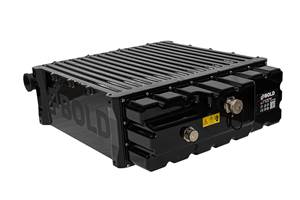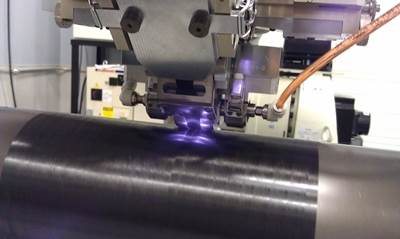Electromagnetically transparent GFRP rotor for rare earth magnet-free electric motors
A research consortium within the Baden-Württemberg’s ICM research cluster has created a prototype GFRP wireless power transfer electric motor rotor.
Demonstrator of the wireless power transfer system with hollow, electromagnetically transparent glass fiber-reinforced polymer (GFRP) rotor shaft. Source | Ludmilla Parsyak, Universität Stuttgart
It’s not news that the automotive industry’s shift toward electrification is a huge technical challenge. However, the electrification itself represents just one part of a complex puzzle for the industry. Most electric motors in modern vehicles rely on rare earth magnets in what are known as permanent magnet synchronous machines (PMSMs). Sourcing these rare earth materials is costly, politically volatile and environmentally damaging, which means serious challenges for electric vehicle (EV) manufacturers.
Electrically excited synchronous machines (EESMs), which use electrically excited rotor windings instead of permanent magnets, offer a viable alternative. Major automakers, such as BMW and Renault, already use EESMs in their production vehicles. However, EESMs need rotating electrical connections that transfer power from a stationary part to a rotating rotor — this is known as slip rings — to energize the rotor, introducing new challenges. Slip rings cause efficiency losses, risk contamination from mechanical wear and require extra installation space, on average 90 millimeters (25-35%) more than PMSMs, according to ZF Friedrichshafen (Friedrichshafen, Germany).
Wireless power transfer (WPT) technology is another solution. WPT systems provide drive by delivering energy through contactless electromagnetic coupling. This occurs without a direct electrical connection between the power source and the rotor, eliminating slip rings. Integrating WPT technology into contemporary rotating machinery is difficult. Rotors, which are often metal, create eddy current losses and distort magnetic fields, reducing WPT efficiency. Some solutions to this use nonmetallic shaft sections that increase shaft diameter and reduce power density.
Combined thinking
A German research consortium led by the University of Stuttgart’s (Stuttgart, Germany) Institute of Electrical Energy Conversion (IEW), in collaboration with the Institute of Aircraft Design (IFB), and cooling specialists from the Institute of Product Engineering at Karlsruhe Institute of Technology (IPEK, Karlsruhe, Germany), set out to address these WPT technology limitations using composites. Their concept uses a hollow rotor shaft which sits within the magnetic flux path of a WPT system made from electromagnetically transparent glass fiber-reinforced polymer (GFRP).
Cross-sectional schematic of integrated wireless power transfer system with GFRP hollow shaft. Source | Andreas Bähr, Universität Stuttgart
The GFRP rotor serves both as a structural component and as a more compact WPT system, enabling up to 95% operational efficiency. The material choice and rotor design contributes to eliminating the rare earth materials, flux guiding materials for the WPT system and mechanical slip rings in conventional EESMs.
The project was funded through Baden-Württemberg’s InnovationCampus Future Mobility (ICM) research cluster (Stuttgart/Karlsruhe, Germany). It was started to demonstrate how advanced electromagnetic field understanding and composite materials can address multiple automotive industry challenges simultaneously. These include the aforementioned supply chain vulnerability, sustainability and performance requirements.
“The critical insight missing from existing approaches was recognizing that electromagnetic transparency and structural function could be treated as complementary design objectives rather than competing requirements,” explains Andreas Bähr, researcher at IEW, University of Stuttgart. “Understanding how to strategically position electromagnetic-neutral materials within the magnetic flux path while maintaining structural integrity required deep comprehension of both composite mechanics and electromagnetic field theory.”
Advanced materials understanding
The team’s systematic approach began with electromagnetic field analysis to map the optimal magnetic flux path for WPT. By designing the GFRP rotor shaft to sit precisely within the flux path, they could eliminate the installation space penalty typically associated with standard steel rotor shafts. This spatial arrangement allows the composite section to serve as a structural torque-transmitting element as well as an electromagnetic window for WPT.
“Despite its higher strength and stiffness and light weight versus glass fiber, carbon fiber reinforcement was deliberately avoided due to its electrical conductivity, which would generate eddy currents and compromise electromagnetic transparency,” notes Holger Ahlborn, researcher at IFB, University of Stuttgart. “This material selection decision exemplifies the team’s thorough understanding of functional requirements versus conventional performance metrics.”
Cross-sectional schematic of a standard EESM shows the stator windings, rotor field coils and installation space inside the rotor hollow shaft. Source | Andreas Bähr, Universität Stuttgart
The team selected EC14 300 TD44C glass fiber rovings from Vetrotex (Chambery, France), specifically chosen for their electromagnetic neutrality and mechanical properties suitable for high-speed rotation. Fiber architecture optimization focused on achieving balanced mechanical properties essential for rotating shafts. The team implemented a ±45° braided configuration using 176 individual fiber rovings processed on a Herzog (Oldenburg, Germany) RF 1-176-100 radial braiding machine.
An 18-layer braided preform design provides load-adapted mechanical behavior while maintaining sufficient permeability necessary for efficient resin infusion during manufacturing.
The approach extended beyond electromagnetic considerations to encompass thermal management and power electronics packaging. “Recognizing that WPT generates heat within the rotating system, we developed a cooling strategy that leverages the composite shaft’s hollow geometry,” explains Simon Knecht, researcher at IPEK, Karlsruhe Institute of Technology. “Rather than treating cooling as a separate system, our methodology positioned thermal management as an integral design driver that influenced both composite architecture and WPT component arrangement and design.”
Matrix selection balanced processability constraints with thermal performance requirements. The team selected Biresin CR172 epoxy resin from Sika (Baar, Switzerland), offering room-temperature vacuum infusion capability while achieving glass transition temperatures exceeding 150°C. This carefully considered compromise enabled laboratory-scale processing while providing adequate thermal performance for the integrated electronic systems positioned within the rotating shaft.
Radial braiding machine manufacturing
A radial overbraiding technique provides continuous fiber deposition with consistent fiber tension in the ±45° orientation optimized for torsional loading. Robotic handling ensures mandrel concentricity accuracy. This is critical for repeatability and quality control.
A Herzog RF 1-176-100 radial braiding machine processes 176 individual EC14 300 TD44C glass fiber rovings in the ±45° orientation to create this electromagnetic-transparent preform (top). Detail of the 18-layer braided preform shows the bi-axial fiber architecture (bottom). Source | Source | Alice Höfler, Universität Stuttgart (top) and Holger Ahlborn, Universität Stuttgart (bottom)
The assembled rotor sees metallic end sections that accommodate bearing interfaces and torque transmission. Composite and metallic section bonding uses 3M (Saint Paul, Minn., U.S.) Scotchweld EC-9323 structural adhesive. This joining method was selected through comprehensive analysis of stress distribution and manufacturing assembly requirements, ensuring the adhesive joint was positioned outside the electromagnetic influence zone of the WPT system.
Vacuum bag infusion, while not optimal for automotive-scale high production volumes, demonstrated the feasibility of the design approach under laboratory constraints. The braided architecture comprises 60% fiber volume fraction with a resulting wall thickness of 5 millimeters. Postprocessing involves precision machining to achieve the dimensional tolerances required for adhesive interfaces and rotor integration into the motor system.
Power system architecture
Primary and secondary coils inside the prototype GFRP WPT system use high-frequency Litz wire from Elektrisola (Reichshof-Eckenhagen, Germany), wound according to electromagnetic modeling calculations and potted with SikaResin RE 531-93 polyurethane casting resin. This semi-flexible potting compound provides thermal conductivity of 0.73 watt per meter-kelvin (W/mK), significantly better than conventional epoxy systems, typically around 0.1-0.3 W/mK, enabling efficient heat transfer to the integrated cooling system.
For the cooling system, topology optimization algorithms were used to design heat sinks specifically for the rotating environment with 180° flow path changes. An air-cooling approach was selected over oil cooling to avoid sealing complexities and potential contamination issues, while still providing adequate heat removal for 3-4 kilowatts (kW) power transfer of the WPT system. This specification is sufficient for the 136-kW peak power goal of the machine.
Power electronics integration represents perhaps the most challenging aspect of the project. By positioning rotating electronics near the rotational center, centrifugal forces are minimized, addressing a critical reliability concern for high-speed automotive applications. The compact electronics package fits within the composite rotor’s hollow geometry while maintaining adequate cooling and electromagnetic compatibility with the WPT system.
Computational fluid dynamics visualization of internal airflow through the integrated cooling system within the rotating composite rotor. Source | Simon Knecht, KIT
Performance validation
Electromagnetic performance validation confirmed the fundamental premise underlying the design approach. The integrated WPT system to the GFRP rotor achieves more than 90% efficiency across the operational range with peak efficiency at 95%. These results demonstrate that the GFRP imposes no meaningful penalty on power transfer efficiency compared to other systems.
Mechanical performance testing focused on the critical interface between composite and metallic sections under representative torsional loading. The bonded joint successfully transfers full motor torque while maintaining concentricity and dynamic balance requirements for high-speed rotation.
Temperature monitoring during operation confirmed that the Biresin CR172 matrix system operates well within its thermal capabilities, with maximum temperatures remaining below 120°C under normal operating conditions. Thermal management validation demonstrated the effectiveness of the integrated cooling. The heat sink cools down the power electronics while the polyurethane-potted coil system efficiently transfers heat to the airflow path, maintaining coil temperatures within safe operating limits during continuous power transfer.
The thermal conductivity of the selected potting compound proves critical for this performance, highlighting how materials knowledge influenced every aspect of system design.
Heat sink development progression shows topology optimization results (left), manual geometric refinement (middle) and final manufactured geometry (right). Source | Simon Knecht, KIT
A reliability assessment indicated potential service life advantages over mechanical slip-ring systems, too. This is due to the elimination of wearing surfaces and debris generation. However, long-term validation of the composite-to-metal adhesive joint under thermal cycling and vibrational loading remains an area requiring extended testing for automotive qualification.
Industry implications
The electromagnetic-transparent GFRP rotor in the EESM WPT system approach addresses multiple industry trends simultaneously, positioning composite materials as enablers of next-generation electric powertrain architectures. Major automotive suppliers including Mahle, Schaeffler and ZF are actively developing WPT technologies for EVs, indicating strong industry momentum toward these types of contactless excitation systems.
Supply chain advantages of the consortium’s GFRP rotor WPT system extend beyond rare earth independence to encompass regional materials sourcing advantages. Glass fiber production capacity exists globally with multiple qualified suppliers, unlike the concentrated rare earth magnet supply chain.
“European automotive manufacturers can potentially achieve greater supply chain resilience while meeting sustainability targets through reduced mining-related environmental impact,” notes Marcel Nöller, project coordinator at ICM research cluster. “The understanding demonstrated in this application also suggests broader applicability across rotating machinery applications. Industrial drives, wind turbine generators and aerospace applications could benefit from similar electromagnetic-transparent composite integration approaches. The fundamental materials knowledge and integration methodology transfer readily to different power scales and operating environments.”
Manufacturing scalability represents the next critical development phase. “While braided preforms demonstrate the technical feasibility, production implementation would likely transition to pultrusion or continuous braiding processes for volume manufacturing,” highlights Ahlborn. “The cylindrical geometry and balanced fiber architecture align well with established composites manufacturing capabilities, suggesting promising scaling economics.”
The successful integration of composites in WPT technology opens new possibilities for multifunctional structural designs in electrified transportation, where materials understanding enables significant advances in efficiency, sustainability and supply chain security.
Related Content
Composites end markets: Sports and recreation (2025)
The use of composite materials in high-performance sporting goods continues to grow, with new advancements including thermoplastic and sustainability-focused materials and automated processes.
Read MoreAviation-specific battery system uses advanced composites to address electric, hybrid flight
BOLDair’s composite enclosure, compression structures and thermal runaway management enables high-performance electric energy storage.
Read MoreOwens Corning initiates review of strategic alternatives for glass fiber business
Owens Corning considers alternative options like a potential sale or spin-off as part of its transformative move to strengthen its position in building and construction materials.
Read MoreORNL demonstrates lightning strike protection tech for composites
Researchers, led by Vipin Kumar, developed a low-cost, recyclable carbon fiber wind turbine blade tip that showed resilience to high-voltage lightning strikes, with more innovations in store.
Read MoreRead Next
Composites end markets: Automotive (2025)
Composites manufacturing intelligence drives circular economy solutions as automotive industry balances technical demands with sustainability mandates.
Read MoreOpportunities and challenges for composites in electric vehicles
Polymer and material specialists at chemical consulting firm ChemBizR reflect on the role of composites in current and future efforts to make electric vehicles more efficient — and more attractive for consumers.
Read MoreProtecting EV motors more efficiently
Motors for electric vehicles are expected to benefit from Trelleborg’s thermoplastic composite rotor sleeve design, which advances materials and processes to produce a lightweight, energy-efficient component.
Read More












